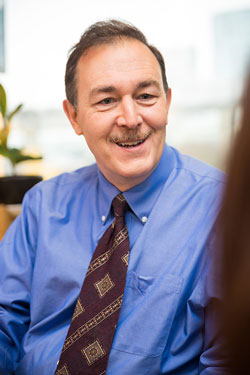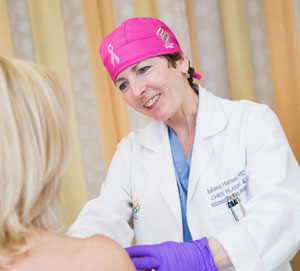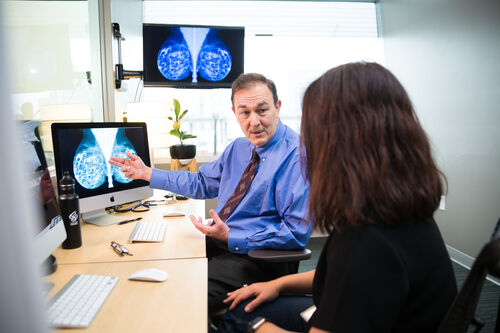Breast Reconstruction Options

Our plastic surgeons offer the latest breast reconstruction techniques for the most natural results possible. They'll work with you and your surgical oncologist to help you choose the option that best meets your needs and wishes.
At the OHSU breast cancer clinic:
- We offer every option, including one-step implants and reconstructions that use a woman's own tissue.
- If you are interested in reconstruction, your plastic surgeon becomes part of your care team from the beginning. This gives you the fullest combination of choices and offers you a chance to look ahead to restorative treatment.
- Your cancer and plastic surgeons work together, enabling most patients to combine procedures into one surgery.
- Breast augmentation, reduction or lift may be options along with reconstruction.
- We respect any patient's decision to not have reconstruction.
Options
Your plastic surgeon will carefully explain the options that can work for you. The surgeon will share before-and-after photos and go over the potential outcomes of each choice. Your surgeon will also provide close follow-up care to ensure the success of your surgery.
Oncoplastic lumpectomy
In this surgery, a surgical oncologist or plastic surgeon sculpts a patient’s own tissue as part of a lumpectomy to ensure that removing the tumor does not leave an indentation.
Nipple- and skin-sparing mastectomy
For some patients, surgeons can spare the nipple and breast skin, leaving an envelope for a particularly natural reconstruction.
Implants

Implants contain saline or silicone gel. Traditional implants require two surgeries — one to place an expander that is slowly enlarged to stretch tissue, then a second to place the implant. We also offer a “direct-to-implant” option that requires only one surgery. Newer options include implants that go under the skin instead of under muscle.
Implants require a shorter recovery time. They are also firmer than natural breasts. They do not grow and contract if you gain or lose weight, and they can make it difficult to achieve symmetry if you have large breasts and want reconstruction on only one side. They also have a limited life span and carry the risk of complications.
Nipple reconstruction and tattooing
If the nipple must be removed as part of cancer surgery, we offer the latest nipple reconstruction techniques using a patient’s own tissue. Realistic three-dimensional tattoos are also an option and can be done as part of or instead of nipple reconstruction.
Your own tissue

We offer the latest “perforator flap” surgeries, in which a breast is sculpted from fat, skin and blood vessels removed from the belly or other area.
Two plastic surgeons working together remove the tissue, called a flap, and move it to the chest. They use microsurgery — delicate surgery performed under a microscope — to connect blood vessels.
This surgery results in an exceptionally realistic breast. The breast will age with other tissue, and it will grow and contract if a patient gains or loses weight. This makes it easier to retain symmetry for patients who have surgery on only one breast. The use of belly tissue makes it similar to a tummy tuck, giving patients a slimmer stomach.
This surgery involves advanced techniques and at least two surgical sites, so it takes longer and requires longer recovery times than implant surgery. On rare occasions, a flap has to be removed if blood flow isn’t enough to keep it healthy.
Types of flap surgeries include:
- DIEP flap surgery is named for the “deep inferior epigastric perforator” blood vessels in the belly. Muscle and fibrous tissue called fascia are left behind, reducing recovery time and the risk of complications. The patient also retains abdominal strength.
- TRAM flap surgery moves part of the “transverse rectus abdominis” muscle along with skin, fat and blood vessels. This type carries more side effects and a higher risk of complications than DIEP flap.
- Latissimus dorsi flap surgery, or LD flap, moves muscle, skin and fat from the back but leaves the blood vessels attached. This type is often combined with an implant to give it a more natural look and feel.
- Other types of flap surgeries use tissue from the thigh, buttocks or back.
Breast augmentation, reduction and/or lift
These procedures can often be combined with lumpectomy or reconstruction surgeries. Some patients welcome the chance to have larger, smaller or higher breasts as part of their treatment.
Symmetry procedures
Some patients have surgery on a breast unaffected by cancer to ensure that it matches a reconstructed breast. The breast may be reduced or lifted, for example.

What to expect
It’s important to understand that not every option is available to every patient. Some patients are too thin for certain flap surgeries, for example. Your plastic surgeon will recommend the best options for you. The surgeon will also explain:
- Risks
- Side effects, such as loss of feeling in the breast and tissue-donation site
- Recovery times
- How a reconstructed breast is different
- Follow-up procedures, such as screening to make sure implants stay intact
Learn more
- Breast cancer surgery at OHSU
- American Society of Plastic Surgeons
- Breast Reconstruction, Breastcancer.org
- Breast Reconstruction Surgery, American Cancer Society
Location
OHSU Breast Center, South Waterfront
Center for Health & Healing, Building 2, ninth floor
3485 S. Bond Ave.
Portland, OR 97239
Free parking for patients and visitors
Refer a patient
- Refer your patient to OHSU.
- Call 503-494-4567 to seek provider-to-provider advice
Cancer clinical trials
Clinical trials allow patients to try a new test or treatment.